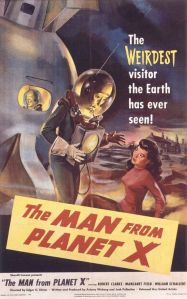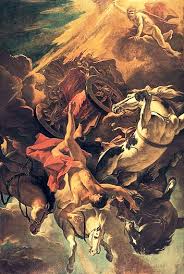Astronomers, in their search for new planets, are constantly positing the existence of worlds that haven’t turned up. Here’s some of the most famous worlds that astronomers have been looking for evidence of.
1. Planet X
 Planet X, despite the numeral, is a hypothetical ninth planet. Oddly, it was first postulated in 1834, before the discovery of an eighth planet. An astronomer called Hansen believed that there would need to two extra planets to explain irregularities in the movements of Uranus. Scientists predicted the position of Neptune without it, but irregularities in the orbit of Neptune caused new problems and the search for Planet X really began.
Planet X, despite the numeral, is a hypothetical ninth planet. Oddly, it was first postulated in 1834, before the discovery of an eighth planet. An astronomer called Hansen believed that there would need to two extra planets to explain irregularities in the movements of Uranus. Scientists predicted the position of Neptune without it, but irregularities in the orbit of Neptune caused new problems and the search for Planet X really began.
Percival Lowell, most famous for his claims about Martian canals, became particularly emotionally caught up in the search. In fact, the stress of searching may have killed him. Lowell would have been pleased that after his death his observatory discovered Pluto. It wasn’t big enough to change Neptune’s orbit, but it was a major breakthrough.
The search for Planet X lasted for over a century, but in 1993 it was suggested that based on data about Neptune from the Voyager 2 flyby, there would be no need for a Planet X. With that, one of the longest hunts for a planet came to a disappointing end.
2. Phaeton

In the 18th century, astronomers noticed that the planets were regularly spaced, provided you place a fifth planet between Mars and Jupiter. This was called the Titius-Bode Law. Excitingly, when they discovered Uranus, it fit the pattern, this led some astronomers to get interested in the missing fifth planet.
In 1801 the first asteroid, Ceres, was discovered, and it looked like the fifth planet had been found just where it was expected to be. However, it was too small, and there were many other asteroids like it in the same area. The idea was put forward that the asteroids were created by the destruction of Phaeton, the fifth planet.
Today, a lot of astronomers would argue the reverse. Not that the asteroids were a planet that became rubble, but that it’s rubble that didn’t become a planet. However, some astronomers are still looking for evidence of a fifth planet.
One theory about a fifth planet ignores its role in forming the asteroid belt entirely and instead tries to explain a period of intense asteroid impacts on Earth. 3.9 billion years ago, they argue, Planet V was half the size of Mars located between Mars and the asteroid belt. It developed an unstable orbit which sent it through the belt and back towards the inner planets, carrying asteroids in its wake. Eventually, its orbit took it into the Sun.
3. Vulcan

The planet Vulcan was first hypothesized by Le Verrier in 1860, he noted irregularities in the orbit of Mercury and believed that a small planet closer to the sun than Mercury may be the cause. In the 1860s and 1870s black dots near the sun were assumed to be Vulcan on a few occasions.
In the 20th century applying astronomers applied the theory of relativity to the orbit of Mercury and found that it worked without there having to be another planet. This left a problem: what were the objects people had seen while looking for Vulcan? Some astronomers believe there may be a small group of asteroids between Mercury and the Sun. Once again, the search for a non-existent planet could turn up some nice new asteroids as a consolation prize.
4. Theia
 The Moon is very much like the Earth in terms of its composition, leading some people to believe that the Moon must have been created when a chunk of the Earth was thrown into space by a giant impact. Theia is a hypothetical planet that developed in a stable area between the Earth and the Sun, but it grew too large and fell towards Earth four billion years ago.
The Moon is very much like the Earth in terms of its composition, leading some people to believe that the Moon must have been created when a chunk of the Earth was thrown into space by a giant impact. Theia is a hypothetical planet that developed in a stable area between the Earth and the Sun, but it grew too large and fell towards Earth four billion years ago.
Estimates on the size of Theia range from Earth sized to the size of Mars, and some reject the idea entirely, saying that Earth and the Moon aren’t similar enough to justify it.
5. Nemesis/Tyche

Nemesis was a red Dwarf Star on a highly eccentric orbit which passes through the Oort Cloud every 28 million years, sending comets into the inner solar system. Each time this happens, it causes a mass-extinction event. The idea that we’re in a binary solar system with a second, secret star of death is a really nice romantic notion. Unfortunately, the telescope we have scouring the skies for Nemesis has turned up nothing. And it is now widely accepted that there’s no red dwarf to be found.
Tyche was a kind of budget-Nemesis. It would only need to be a few times bigger than Jupiter, and was an attempt to explain the orbits of comets, and, later, of Sedna. It was first suggested in 1999, but there was a spate of stories about how “scientists could soon discover a new planet” in 2011. But it didn’t seem to be based on anything more than the fact that we had the technology to look for it. So far, there’s no evidence that such a planet is out there.
6. Fifth Gas Giant
Some current theories of planetary formation indicate that gas giants like Neptune and Uranus are too far out to have evolved in their current orbits. If this is true, they must have been created closer to the sun, and migrated outwards. Unsurprisingly, it’s difficult to move a herd of gas giants out of a young solar system full of debris without destroying any smaller rocky worlds in the region.
Some astronomers believe that the best way to get the outer planets from where they think they were created to their current orbits would be to have a fifth gas giant that had a “violent encounter” with Jupiter, that pushed the gas giants out and ejected the fifth world from the system.
In 2013, we started to find rogue planets, which have probably been ejected from their own solar systems into deep space. So it’s a possibility. Maybe in the next few decades we can start to locate planets that have been kicked out of our own system.
So what…
We tend to think of planets as an unchanging, monolithic kind of thing. But it seems that conditions everywhere have been shaped by planets swapping places in the past, and they may move again in the future.
Is this a random process, ruled by chance alone? The fact that planets are regularly spaced could indicate a pattern behind it, but the Titius-Bode Rule failed to predict the location of Neptune, so maybe it was just a coincidence. However, some astronomers are starting to see similar patterns in other systems. So, maybe there’s some kind of reason and pattern to these movements. I don’t know, ask a scientist. Or if you want a definitive answer, your best bet is to just ask God. If you can find him.